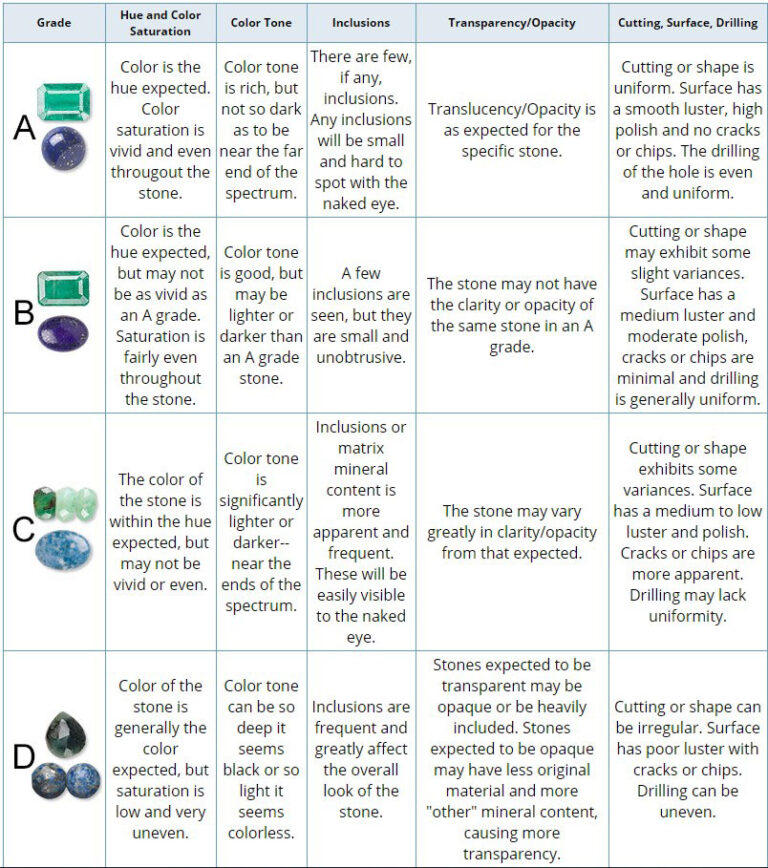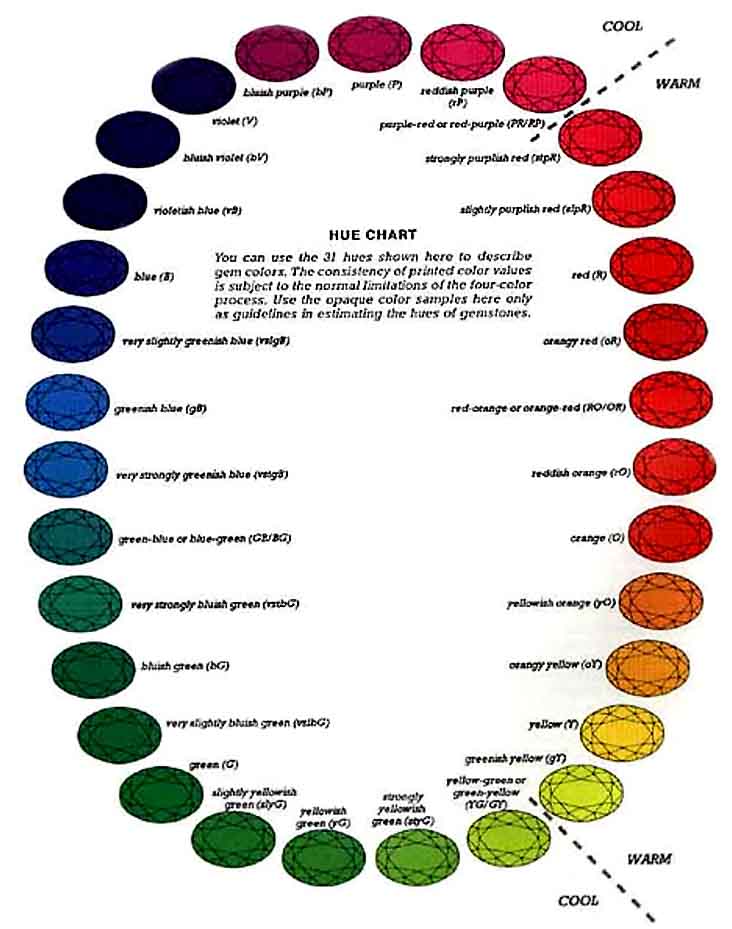Have you ever wondered how gemstones are graded? It can be quite difficult to understand the complex process, but fret not! We've got you covered with this Gemstone Grading Chart.
Introduction
Gemstone grading is the process of evaluating the quality of a gemstone based on various factors such as color, clarity, cut, and carat weight. The aim of this process is to determine the value of the gemstone.
There are several bodies that provide gemstone grading services. The most renowned among them is the Gemological Institute of America (GIA). Other notable institutions include the American Gem Society (AGS), the International Gemological Institute (IGI), and the European Gemological Laboratory (EGL).
About
The Gemstone Grading Chart provides an insightful view of the various factors that affect a gemstone's value. Here's a brief overview of the parameters included in this chart:
Color
Gemstone color is one of the most important factors in determining its value. The chart provides an overview of the color range and their respective values. It's important to note that some gemstones are more valuable in specific colors. For example, blue sapphires are more valuable than other colored sapphires.
Clarity
Gemstone clarity is a measure of its visual purity. The chart provides an overview of the range of clarity levels and their respective values. It's important to note that some gemstones are naturally more included than others.
Cut
Gemstone cut refers to the way a gemstone is faceted. The chart provides an overview of the range of cut grades and their respective values. It's important to note that some gemstones are more valuable when cut into specific shapes.
Carat Weight
Gemstone carat weight refers to the mass of the stone. The chart provides an overview of the range of carat weights and their respective values. It's important to note that some gemstones are more valuable at specific carat weights.
FAQ
What is the difference between GIA and other gemstone grading institutions?
GIA is widely recognized as the standard in gemstone grading as their grading process is the most stringent. Other institutions may have less stringent grading systems resulting in more variation in grades; hence the value of the same gemstones may vary across different labs.
Can I grade a gemstone on my own?
If you are not an expert in gemstone grading, it's best to leave it to the professionals. Attempting to grade a gemstone without the proper knowledge and equipment can be risky and may result in inaccurate grading.
Why does gemstone color affect its value?
Gemstone color is one of the most important factors in determining its value because it's what makes a gemstone visually appealing. Some colors are rarer than others, making them more valuable. Additionally, certain colors are more popular and sought after, leading to higher demand.
Why is it important to consider gemstone cut?
The cut of a gemstone affects both its beauty and value. A poorly cut gemstone will not reflect light properly and will look dull. Additionally, some gemstones are more valuable when cut into specific shapes, such as diamonds that are most valuable when cut into round brilliant shapes.
What is the significance of gemstone clarity?
Gemstone clarity is important because it affects the visual purity of the gemstone. A gemstone with high clarity will look more brilliant, whereas a gemstone with low clarity will look less brilliant and may have visible inclusions that affect its value.
Now that you understand the fundamentals of gemstone grading, you'll be better equipped to appreciate and value the gemstones you encounter.

Gemstone Grading - North Brisbane Lapidary Club
At the North Brisbane Lapidary Club, we take pride in our gemstone grading process. Our experienced team of gemologists use the latest equipment and methods to ensure that our grading is accurate and fair.
We offer gemstone grading services for a variety of gemstones, including sapphires, emeralds, rubies, and diamonds. Our grading process includes evaluations of color, clarity, cut, and carat weight.
If you're looking to buy or sell gemstones, our grading service can help you accurately determine the value of the gemstones you're working with. And if you're just interested in learning more about gemstones, our team is always happy to answer questions and provide further information.

Gemstone Color Charts | Singapore Island Jewellery Store
Choosing the right color of a gemstone can be a daunting task. Fortunately, the Singapore Island Jewellery Store has an extensive range of gemstone color charts to help make the process easier.
Our color charts provide an overview of the full spectrum of colors available for each gemstone, as well as a guide to the most valuable and sought-after colors for each stone. We also offer expert advice on color combinations and complementary stones, to help you make the perfect color choices for your jewellery.
Visit our store today to view our color charts and consult with our experienced team of gemologists.
Gemstone Colour Grading (GIA) | Sapphire color, Gemstone colors
The Gemological Institute of America (GIA) is recognized as the world's foremost authority in gemstone grading. As such, their gemstone color grading system is considered the standard by which all others are measured.
GIA's color grading system relies on a set of master stones, which are used to determine the color grade of a gemstone based on its proximity to the color of the master stone. The color grading system is based on a scale from D (colorless) to Z (light yellow or brown).
For colored gemstones, the GIA uses a descriptive system that takes into account hue, tone, and saturation. Hue refers to the gemstone's basic color (e.g. red, blue, green), while tone refers to the darkness or lightness of the color. Saturation refers to the intensity of the color.

F.A.Q. Gemstones: Facts & Info – GemEarth
At GemEarth, we believe that education is the key to making informed decisions when it comes to gemstones. That's why we've compiled a list of frequently asked questions to help you better understand the world of gemstones.
What are the most valuable gemstones?
The value of a gemstone is determined by a combination of factors, including rarity, beauty, and demand. Some of the most valuable gemstones include diamonds, rubies, emeralds, and sapphires.
What is a "semi-precious" gemstone?
The term "semi-precious" is a misnomer that was used in the past to refer to gemstones that were considered less valuable than precious gemstones such as diamonds, sapphires, rubies, and emeralds. However, the term is largely outdated and is no longer used by industry professionals.
What are the most popular gemstones?
The most popular gemstones vary by region and culture, but some of the most commonly sought-after gemstones include diamonds, emeralds, sapphires, and rubies.
What is the history of gemstones?
Gemstones have been prized for their beauty and rarity for thousands of years. Throughout history, gemstones have been used for a variety of purposes, including adornment, currency, and even as medicine. Some of the earliest recorded use of gemstones dates back to ancient Egypt, where they were believed to have mystical properties.
Are synthetic gemstones the same as natural gemstones?
Synthetic gemstones are created in a laboratory using processes that mimic the formation of natural gemstones. While synthetic gemstones may have the same physical and chemical properties as natural gemstones, they are not considered the same as natural gemstones and may have a lower value in the market.

Tanzanite Color Grading - So Many Systems, Which to Trust?
Tanzanite is a relatively new gemstone, discovered in Tanzania in the 1960s. Due to its unique coloration and rarity, it has become a highly sought-after gemstone in recent years.
However, the grading of tanzanite can be a confusing process. There are several different grading systems in use, each with its own unique methodology.
The most widely recognized method of tanzanite grading is the one used by the Tanzanite Foundation, which evaluates tanzanite based on a combination of color, clarity, and cut. Other grading systems, such as those used by the GIA and IGI, are also used in some cases.
Ultimately, the key to accurately valuing tanzanite is to work with a reputable gemstone dealer who has experience and expertise in grading and valuing tanzanite.

We hope that this Gemstone Grading Chart and the accompanying information has provided you with a better understanding of the world of gemstones. Remember, always work with reputable gemstone dealers and seek out reliable information when making decisions about buying or selling gemstones.